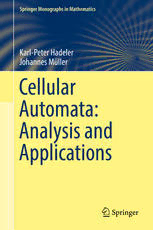
Cellular Automata: Analysis and Applications PDF
Preview Cellular Automata: Analysis and Applications
Springer Monographs in Mathematics Karl-Peter Hadeler Johannes Müller Cellular Automata: Analysis and Applications Springer Monographs in Mathematics Editors-in-Chief IsabelleGallagher MinhyongKim Moreinformationaboutthisseriesathttp://www.springer.com/series/3733 Karl-Peter Hadeler • Johannes MuRller Cellular Automata: Analysis and Applications 123 Karl-PeterHadeler JohannesMuRller FBBiologie CentreforMathematicalSciences UniversitaRtTuRbingen TechnicalUniversityMunich TuRbingen,Germany Garching,Germany ISSN1439-7382 ISSN2196-9922 (electronic) SpringerMonographsinMathematics ISBN978-3-319-53042-0 ISBN978-3-319-53043-7 (eBook) DOI10.1007/978-3-319-53043-7 LibraryofCongressControlNumber:2017937054 ©SpringerInternationalPublishingAG2017 Thisworkissubjecttocopyright.AllrightsarereservedbythePublisher,whetherthewholeorpartof thematerialisconcerned,specificallytherightsoftranslation,reprinting,reuseofillustrations,recitation, broadcasting,reproductiononmicrofilmsorinanyotherphysicalway,andtransmissionorinformation storageandretrieval,electronicadaptation,computersoftware,orbysimilarordissimilarmethodology nowknownorhereafterdeveloped. Theuseofgeneraldescriptivenames,registerednames,trademarks,servicemarks,etc.inthispublication doesnotimply,evenintheabsenceofaspecificstatement,thatsuchnamesareexemptfromtherelevant protectivelawsandregulationsandthereforefreeforgeneraluse. Thepublisher,theauthorsandtheeditorsaresafetoassumethattheadviceandinformationinthisbook arebelievedtobetrueandaccurateatthedateofpublication.Neitherthepublishernortheauthorsor theeditorsgiveawarranty,expressorimplied,withrespecttothematerialcontainedhereinorforany errorsoromissionsthatmayhavebeenmade.Thepublisherremainsneutralwithregardtojurisdictional claimsinpublishedmapsandinstitutionalaffiliations. Printedonacid-freepaper ThisSpringerimprintispublishedbySpringerNature TheregisteredcompanyisSpringerInternationalPublishingAG Theregisteredcompanyaddressis:Gewerbestrasse11,6330Cham,Switzerland Contents 1 Introduction................................................................. 1 1.1 Discreteness .......................................................... 1 1.2 TheGameofLife .................................................... 3 1.3 ContactAutomata.................................................... 4 1.4 SomeWolframAutomata............................................ 6 1.5 Greenberg-HastingsAutomata ...................................... 10 1.6 Langton’sAntandLifeWithoutDeath ............................. 11 1.7 ANiceLittleAutomaton............................................. 12 1.8 HistoryandApplications............................................. 13 1.9 OutlineofThisWork................................................. 13 2 CellularAutomata:BasicDefinitions .................................... 19 2.1 TheGrid .............................................................. 19 2.1.1 AbelianorRegularGrids................................... 20 2.1.2 Non-AbelianGrids ......................................... 22 2.2 TheNeighborhood ................................................... 26 2.3 ElementaryStateandtheGlobalState.............................. 28 2.4 TheLocalandtheGlobalFunction.................................. 30 2.5 Excursion:TheGrowthFunctionofaCayleyGraph............... 33 3 CantorTopologyofCellularAutomata.................................. 37 3.1 Prelude:CantorSetsandCantorSpaces ............................ 38 3.1.1 TheClassicalMid-ThirdCantorSet....................... 38 3.1.2 CantorSpaces............................................... 42 3.2 CantorMetricforCellularAutomata................................ 45 3.3 TheCurtis-Hedlund-LyndonTheorem.............................. 48 3.4 SpatialStructureandSimplifications................................ 52 3.4.1 Examples:StructuresThatAreNotCellular Automata.................................................... 57 3.4.2 SimplificationoftheStateSpace .......................... 60 v vi Contents 3.4.3 SimplificationoftheNeighborhood....................... 61 3.4.4 SimplificationoftheGrid.................................. 62 3.5 CellularAutomataandContinuousMapsonCantorSpaces....... 65 3.5.1 BijectiveMaps.............................................. 66 3.5.2 GeneralMaps:TheUniversalCellularAutomaton....... 67 4 BesicovitchandWeylTopologies.......................................... 75 4.1 DefinitionoftheBesicovitchandWeylSpace...................... 75 4.2 TopologicalProperties ............................................... 81 4.2.1 BesicovitchSpaces ......................................... 82 4.2.2 WeylSpaces................................................. 90 4.3 CellularAutomataonBesicovitchandWeylSpaces............... 98 4.4 ACHLTheoremforBesicovitchandWeylSpaces ................ 103 5 Attractors.................................................................... 111 5.1 DynamicalSystems,!-LimitSetsandAttractors.................. 112 5.1.1 DynamicalSystems......................................... 112 5.1.2 !-LimitSetsandAttractors................................ 114 5.2 StructureofAttractors:FiniteGrids................................. 119 5.3 IntersectionofAttractorsandQuasi-Attractors..................... 119 5.4 ConleysDecompositionTheorem,Attractors,andChains......... 125 5.5 BernoulliMeasureonCellularAutomata........................... 132 5.6 StructureofAttractors—InfiniteGrids:HurleyClassification..... 140 6 ChaosandLyapunovStability ............................................ 155 6.1 TopologicalChaos.................................................... 155 6.2 PermutingCellularAutomata........................................ 159 6.2.1 SurjectiveCellularAutomata .............................. 160 6.2.2 TopologicalTransitivity.................................... 165 6.2.3 DensenessofPeriodicPoints .............................. 166 6.3 LyapunovStabilityandGilmanClassification...................... 169 6.3.1 ClassGilman1.............................................. 171 6.3.2 ClassGilman2.............................................. 173 6.3.3 ClassGilman3.............................................. 174 6.3.4 ClassGilman4.............................................. 175 7 LanguageClassificationofKu˚rka ........................................ 179 7.1 Grammar.............................................................. 179 7.2 FiniteAutomata ...................................................... 181 7.3 FiniteAutomataandRegularLanguages ........................... 184 7.4 CellularAutomataandLanguage:Ku˚rkaClassification ........... 186 7.4.1 ClassKu˚rka1............................................... 190 7.4.2 ClassKu˚rka2............................................... 191 7.4.3 Ku˚rka3...................................................... 194 8 TuringMachines,Tiles,andComputability............................. 197 8.1 TuringMachines ..................................................... 197 8.2 UniversalTuringMachine ........................................... 201 Contents vii 8.3 ComputationalUniversalityofCellularAutomata ................. 205 8.4 UndecidableProblems............................................... 207 8.4.1 TheParadoxofEpimenides................................ 207 8.4.2 Russel’sParadox............................................ 208 8.4.3 Richard’sParadox .......................................... 209 8.4.4 TheWordProblem ......................................... 210 8.4.5 TheHaltingProblem ....................................... 211 8.4.6 TheImmortalityProblem .................................. 213 8.4.7 Non-computabilityof!-LimitSetsforCellular Automata.................................................... 213 8.5 Tiles................................................................... 214 8.5.1 DefinitionsandExamples.................................. 214 8.5.2 TessellationsofFreeGroups............................... 217 8.5.3 AperiodicTessellationsonZ2.............................. 220 8.5.4 UndecidabilityoftheDominoProbleminZ2............. 232 8.5.5 UndecidabilityoftheFiniteDominoProbleminZ2...... 239 8.5.6 GrouporGraph............................................. 246 8.5.7 DominoProblemandMonadicSecondOrderLogic..... 249 9 SurjectivityandInjectivityofGlobalMaps ............................. 253 9.1 TheGardenofEden.................................................. 254 9.2 AlgorithmsforOne-DimensionalCellularAutomata.............. 262 9.2.1 StationaryPoints............................................ 262 9.2.2 Surjectivity.................................................. 267 9.2.3 InjectivityandBijectivity .................................. 275 9.3 UndecidabilityHigherDimensionalCellularAutomata ........... 279 9.3.1 StationaryPoints............................................ 280 9.3.2 Surjectivity.................................................. 280 10 LinearCellularAutomata................................................. 287 10.1 RepresentationofLinearCellularAutomata........................ 287 10.2 Surjectivity,InjectivityandBijectivity.............................. 292 10.3 FractalSetsandLinearCellularAutomata.......................... 296 10.3.1 IntroductoryExampleandtheFermatProperty........... 297 10.3.2 LimitSetsofLinearCellularAutomata................... 300 10.3.3 IteratedFunctionSystems.................................. 307 10.3.4 MatrixSubstitutionSystems............................... 314 10.3.5 CellularAutomataandMatrixSubstitutionSystems..... 324 11 ParticleMotion ............................................................. 335 11.1 ParticleMotion:FormalApproach.................................. 335 11.1.1 ModellingDiffusionbyContinuousModels.............. 336 11.1.2 NaiveCellularAutomataModelsforDiffusion........... 338 11.2 FromPDEtoCellularAutomata:UltradiscreteLimit.............. 340 11.2.1 HeatEquation............................................... 342 11.2.2 TheBurgersEquation ...................................... 343 11.2.3 UltradiscreteLimitandBurgersEquation................. 350 viii Contents 11.3 MicroscopicModelsforDiffusion .................................. 354 11.3.1 StraightMovement ......................................... 355 11.3.2 LatticeGasCellularAutomata............................. 360 12 PatternFormation.......................................................... 377 12.1 FractalMolluscPatterns ............................................. 377 12.2 TuringPattern ........................................................ 378 12.2.1 Turing-PatterninPartialDifferentialEquations .......... 378 12.2.2 Excursion:HopfieldNets................................... 380 12.2.3 Bar-Yam-ModelforTuringPattern........................ 384 12.3 Greenberg-HastingsModelforExcitableMedia ................... 386 12.3.1 Definitions .................................................. 387 12.3.2 TheWindingNumber ...................................... 391 12.3.3 ThePotential................................................ 396 12.3.4 SurvivalofConfigurations................................. 400 13 ApplicationsinVariousAreas............................................. 405 13.1 SandpileAutomataandSelf-OrganizedCriticality................. 405 13.2 Epidemiology......................................................... 411 13.2.1 MeanFieldApproximation ................................ 411 13.2.2 SIRSModelandMeanFieldApproximation............. 413 13.2.3 PolynomialGrowth:ClusteringofContactNetworks.... 416 13.3 Evolution ............................................................. 418 13.3.1 Evolution.................................................... 419 13.3.2 SpatialModel............................................... 420 13.3.3 HeuristicAnalysis.......................................... 423 A BasicMathematicalTools.................................................. 427 A.1 BasicDefinitionsfromTopology.................................... 427 A.2 BasicAlgebraicTheory.............................................. 433 A.2.1 GroupTheory............................................... 433 A.2.2 RingTheory................................................. 438 A.2.3 Fields........................................................ 441 A.3 BasicMeasureTheory ............................................... 442 References......................................................................... 455 Index............................................................................... 463 List of Symbols Wegivealistofsomenotationswithareferencetothefirstpagewherethenotation appears. Symbol Page Meaning Œa(cid:2),Œab(cid:2) 162 Concatenationofsignsor(finite)sequences Œa(cid:2),Œ0(cid:2) 151 StateinEZthatisidenticallya(or0) kzk1 25 `1-normofavectorz kzk 27 `1-normofavectorz 1 ŒGWH(cid:2) 29 IndexofasubgroupH ofG jXj 33 SizeofsomesetX 0 26 Neutralelementofagroup,originofthegrid (Abeliancase) A 116 Conleyattractor A 120 Setofallattractors A.f/ 55 Setofbijectivefunctionscommutingwithf B .x/ 46 Openballaroundxwithradiusrinametricspace r B.:/ 117,131 Basinofattraction(forattractorsresp.chain components) B 134 Borelalgebra C 52 Cantorspaceormetric,compact,andtotally disconnectedspace C1=3 39 Themid-thirdCantorset CR.f/ 125 Recurrentpoints d.u;v/ 45 CantordistancebetweentwostatesinE(cid:3) d.n1;n2/ 387 UnsigneddistanceonZm d .g;h/ 25 DistancebetweentwoelementsonaCayley c graph ix
